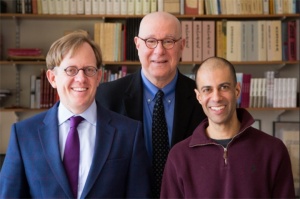Vipin Narang: On the brinkmanship beat
Vipin Narang studies the strategic use of nuclear force at a time when global tensions approach the boiling point

Stuart Darsch/MIT Political Science
Vipin Narang studies the strategic use of nuclear force at a time when global tensions approach the boiling point
It’s a wonder that Vipin Narang gets any sleep these days. The Mitsui Career Development Associate Professor of Political Science, Narang specializes in nuclear security, proliferation, and deterrence. It is work that has never seemed more urgent.
Today, Narang is closely monitoring the ongoing rivalry between India and Pakistan, and the alarming, bellicose sparring between North Korea and the United States.
“If Kim Jong-un thinks the US is coming after him, and Trump fires off a tweet that appears provocative, I can imagine the North Korean leadership seeing itself with no choice but to use its conventional and potentially nuclear weapons preemptively, because they would have to rightly fear that the US could destroy most, if not all, of their nuclear forces,” says Narang.
His Twitter feed provides a steady stream of nail-biting news. One recent evening, he was sharing real-time seismic information for the Korean peninsula, awaiting new underground nuclear testing by North Korea.
For Narang, diligent maintenance of his social media sites is part of the job. “I try to use my academic training and scholarship to make the pressing nuclear security issues of the day relevant and accessible to the public and policy makers.”
He frequently contributes to such newspapers as The Hindu and Indian Express, and to the journal Foreign Policy. The New York Times routinely seeks his expert commentary, and he engages in security meetings with government officials.
Fueling this engagement with the public, the policy community, and students is Narang’s rigorous scholarship in the ways states wield nuclear force to achieve their interests. His current research focuses on his second planned book, Strategies of Nuclear Proliferation.
“Understanding how states acquire nuclear weapons is important in terms of improving nonproliferation policy,” says Narang, who recently became an associate professor with tenure. He cites a recent case as a success story: “With Iran’s nuclear weapon program, we managed to move a state from a hiding strategy to a hedging strategy,” he notes. “While Iran may not have fully given up on its nuclear aspirations, the deal pushed them back to a more ambivalent hedging position which is a nonproliferation win.”
He has adopted an unusual approach to nonproliferation research. “Most academic literature focuses on the ‘why,’ whereas I focus on the ‘how,’ says Narang. “It gives the international community different things to look out for when trying to formulate new policy or strategies with an aspiring nuclear state.”
Narang’s singular take on security issues began quite early in his career. In graduate school at Harvard University a decade ago, he received cautionary advice to steer clear of nuclear questions. “Most in my discipline thought it was a dead field,” he recalls. “They wondered if I had anything new to say about nuclear weapons that had not been said during the Cold War.”
As it happened, Narang did. “That was because I was focused on regional nuclear powers, such as China, India, and Pakistan, not on U.S. or Soviet superpower strategy,” he says. “There were eight non-superpower states with small arsenals, many bordering each other, with a history of enmity and disputes—I had a good sense there would be something new to say about them.”
Narang’s doctoral research investigated common nuclear strategies among these states, and whether their smaller arsenals deterred conflicts. This comparative study of regional nuclear powers, which included not just South Asia, but China, Israel, France, and South Africa, demonstrated that “nuclear weapons by themselves don’t confer automatic benefits,” he says “Nuclear theology in the academy was that once a state acquires nuclear forces, other states are afraid to pick fights, but I showed that nuclear weapons don’t necessarily deter conventional attacks just by their existence.”
This research served as the basis for Narang’s first book, Nuclear Strategy in the Modern Era: Regional Powers and International Conflict (Princeton, NJ: Princeton University Press, 2014), which won the 2015 International Studies Association International Security Section Best Book Award.
As a child of Indian immigrants, Narang grew up “a South Asia watcher,” he says, and his keen interest in military conflict emerged when he was quite young. “We used to go to Punjab during the insurgency,” he recalls. “The army would take over our train when it crossed into the state and, as a 10-year-old, I was fascinated by the security situation.”
This fascination blossomed during high school, when Narang was a policy debater. “While I was researching U.S. foreign policy toward China, what excited me the most was learning about Chinese nuclear strategy.”
Even while a chemical engineering major at Stanford University, Narang managed to nurture his interest in foreign policy and security. His undergraduate thesis concerned India’s secret chemical weapons program. “It was a little piece of security history no one had known about, and I got into the nature of the weapons stockpile, and India’s decision to reveal and ultimately dismantle it.”
Narang’s conclusive pivot to his current field came at Oxford University, where he spent two years as a Marshall Scholar. There, he says, “I realized I cared about foreign policy, especially the security side and the technology of security.”
Today, as he completes his book on nuclear acquisition, Narang contemplates a future one on strategies of nuclear coercion. His research will focus on whether nuclear weapons successfully work as leverage for one state “to try to get another state actor to change its behavior,” he says. Think 1962 Cuban missile crisis and the U.S.-Soviet standoff, he says.
This crisis resonates during the current tense situation with North Korea. Narang is not an optimist about how the Korean, or other conflicts, will turn out. “The development of nuclear weapons was designed to prevent massive, conventional wars,” he says. “But we have traded the Cold War era’s lower risk of catastrophic global nuclear annihilation for today’s higher risk of serious but limited use of nuclear weapons by regional states.”
As a relatively new father, weighing these options feels more than academic to Narang. He does not see a way to undo the existence of nuclear weapons, but he does believe there might be a way to manage them. The central challenge is managing stable nuclear deterrence relationships at lower numbers between states that have deep historical rivalries. “On the one hand, we want regional powers to avoid the arms race mistakes of the Cold War,” he says. “But on the other hand, we don’t want them to have such small and vulnerable nuclear forces that they believe that they may have to use them before they lose them.”

